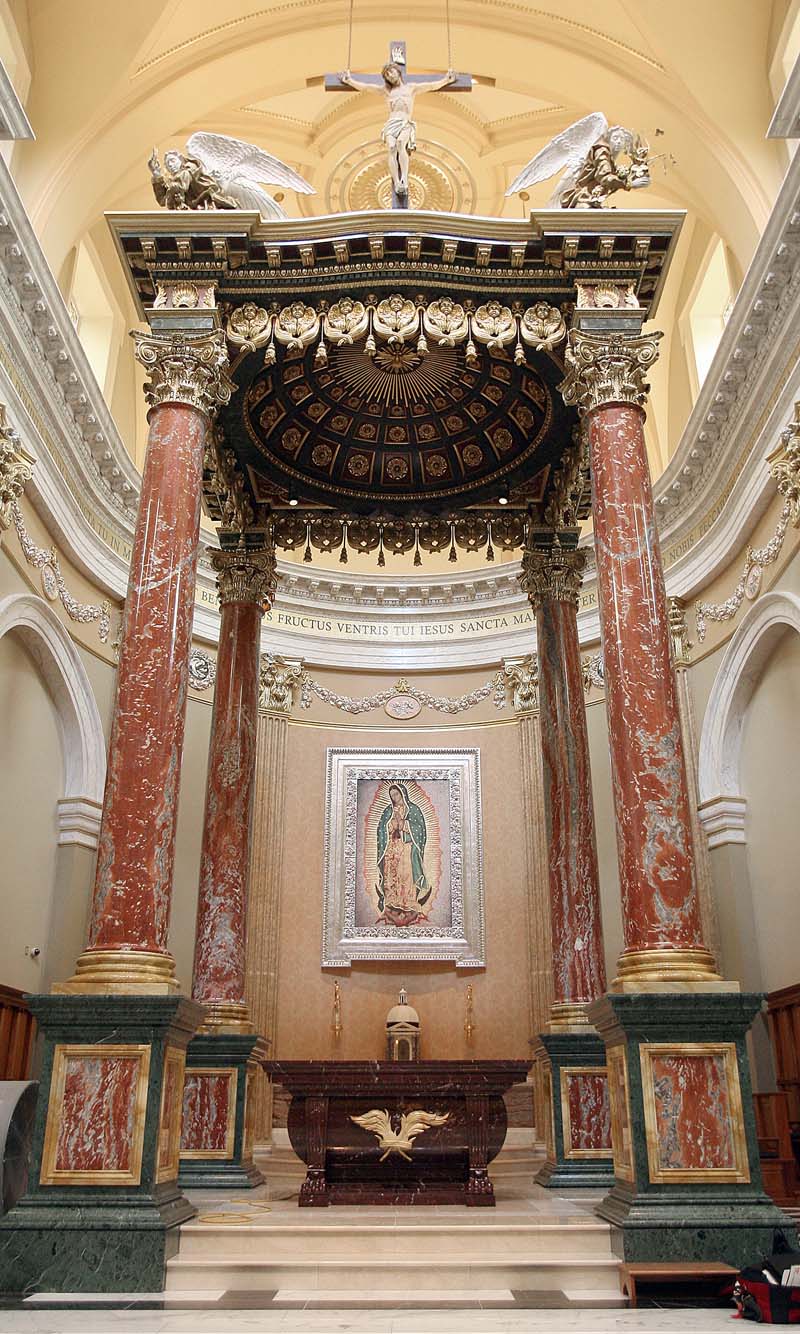 The opening of the Guadalupe Shrine in LaCrosse raises some significant questions. Is simply “going back” to the past a suitable way to build churches. The answer is no. Does this mean that the past is banished? Also, no.
The opening of the Guadalupe Shrine in LaCrosse raises some significant questions. Is simply “going back” to the past a suitable way to build churches. The answer is no. Does this mean that the past is banished? Also, no.
The point is that a church should be what a church is: a fulfillment of the Old Testament Temple, a marker of Christ operative in our world, and an icon of the Heavenly Jerusalem. It reaches to the past, proclaims the Truth today and anticipates the glory and perfection of heaven. All three of these things must be at work for a church to be theologically as rich as it ought to be. So we see that the today’s tabernacle is a fulfillment of the time when God’s presence rested on the Ark in the Holy of Holies of the Temple: in the Real Presence, God abides with us substantially and constantly. Moreover, the church building not only recalls the past, but reminds us that God is operative in our world, that worship is important, of a high dignity, and makes us more ordered and more loving by being the vehicle for reception of grace. And grace is that share of divine life which restores us to our pre-fallen state and glorifies us to be heavenly. And so a church shows us what that heavenly future will be like: perfected, rich, radiant, glorified, theocentric, with creation redeemed (the lion will lay down with the lamb) and heaven and earth joined: angels, saints and the Trinity existing “as it was in the beginning.” This is what a church is supposed to make present for us.
The word “style” has not yet appeared in this post until now. Whether a building is Gothic or Romanesque isn’t the primary issue. The primary issue is that a building is a clear icon of theological realities (see Sacrosanctum Concilium, 123). Some styles are better at this than others. But styles are a set of facts: pointed arches vs. round arches, medieval vs. Baroque, etc. What we should be dealing with is the Truth. God created us, we fell, he redeemed us, and he shares his life with us through material things, primarily the Eucharist and the other sacraments, but also through art and architecture. Here is the goal of a church building. This is why Vatican II says “the art of our own day should be given free scope in the Church provided that it brings due honor and reverence to the rites.” This is not freedom to build bad things as the secular culture tells us. It is the freedom to be excellent, sacramental, and theological rather than merely mediocre, historical and fact-oriented.
The new shrine in LaCrosse sticks quite close to a recognizable precedent, but it is not a copy of anything. Its paintings portray new saints and its materials are local and use modern technology. But it uses gold and rare marbles because they tell us that the church is important, not just because they are “old fashioned.” Is uses a baldachino because the altar beneath it is important, not just because baldachinos are historical. It makes the sacristy chapel-like because sacristies are places where a priest prays as he vests to celebrate Mass and gets prepared to enter the very mysteries of heaven, not because sacristies were nice “in the old days.” Could they have built a beautiful Gothic chapel? Sure. Romanesque? Sure. Modernist? Much harder. Why? Modernism is a philosophical system which denies the specificity of sacramentality and is rooted in Enlightenment skepticism. It is not the style of Modernism which is the problem per se, but the philosophy and theology that that style represents. One simply can’t sing a hymn to the devil at Mass (untruth), even if its style is very pretty, popular, or used by the cultural elites (the facts). So it is with architecture. Architecture means something, it is the built form of ideas. The Truth must always win over the facts. But the proper facts will always emerge when the Truth is properly used just as the right cake results from the right ingredients.
So we rejoice in our beautiful architecture, drawing from the past, but speaking anew to a new world in a new time. We make small adaptations to make the same Truth better understood. We do not decide that the past is over and gone and reinvent the wheel. Similarly, we do not reproduce the past exactly. We don’t have ourselves nailed to the cross to copy Christ. We offer small sacrifices to God in imitation of Christ. We don’t walk around with a beard and long hair to copy Christ. We live simply and justly in our own place and time to imitate Christ. We don’t copy the simplicity of the Upper Room of the Last Supper, we recall it and show its fulfillment in a glorious architecture which anticipates the glory of heaven. Here is the mercy of God in marvelous display: he allows us to use the things of this earth to share in the glory of heaven. Here is the ultimate goal of liturgical art and architecture.

Leave a Reply